Analyzing Decision Making Techniques for DD plc Investment Project
VerifiedAdded on 2023/06/13
|9
|1416
|166
Essay
AI Summary
This essay explores the application of decision-making techniques, specifically the payback period and Net Present Value (NPV), in the context of investment projects for DD plc, a vegetarian food manufacturing company. It calculates and compares the payback periods for Project A (smoothies) and Project B (non-dairy milk), concluding that Project A has a slightly shorter payback period. The essay then calculates the NPV for both projects, determining that both have positive NPVs, making them potentially viable, but Project B has a higher NPV. Furthermore, the essay discusses the importance of both financial factors, such as acquired assets, income, and cost of goods sold, and non-financial factors, including motivating staff and improving brand image, in the overall decision-making process for a business. The analysis emphasizes that a comprehensive approach, considering both quantitative and qualitative aspects, is crucial for making informed and effective business decisions. Desklib offers a wealth of resources, including solved assignments and past papers, to aid students in understanding these complex concepts.

Decision Making
Techniques
Techniques
Paraphrase This Document
Need a fresh take? Get an instant paraphrase of this document with our AI Paraphraser
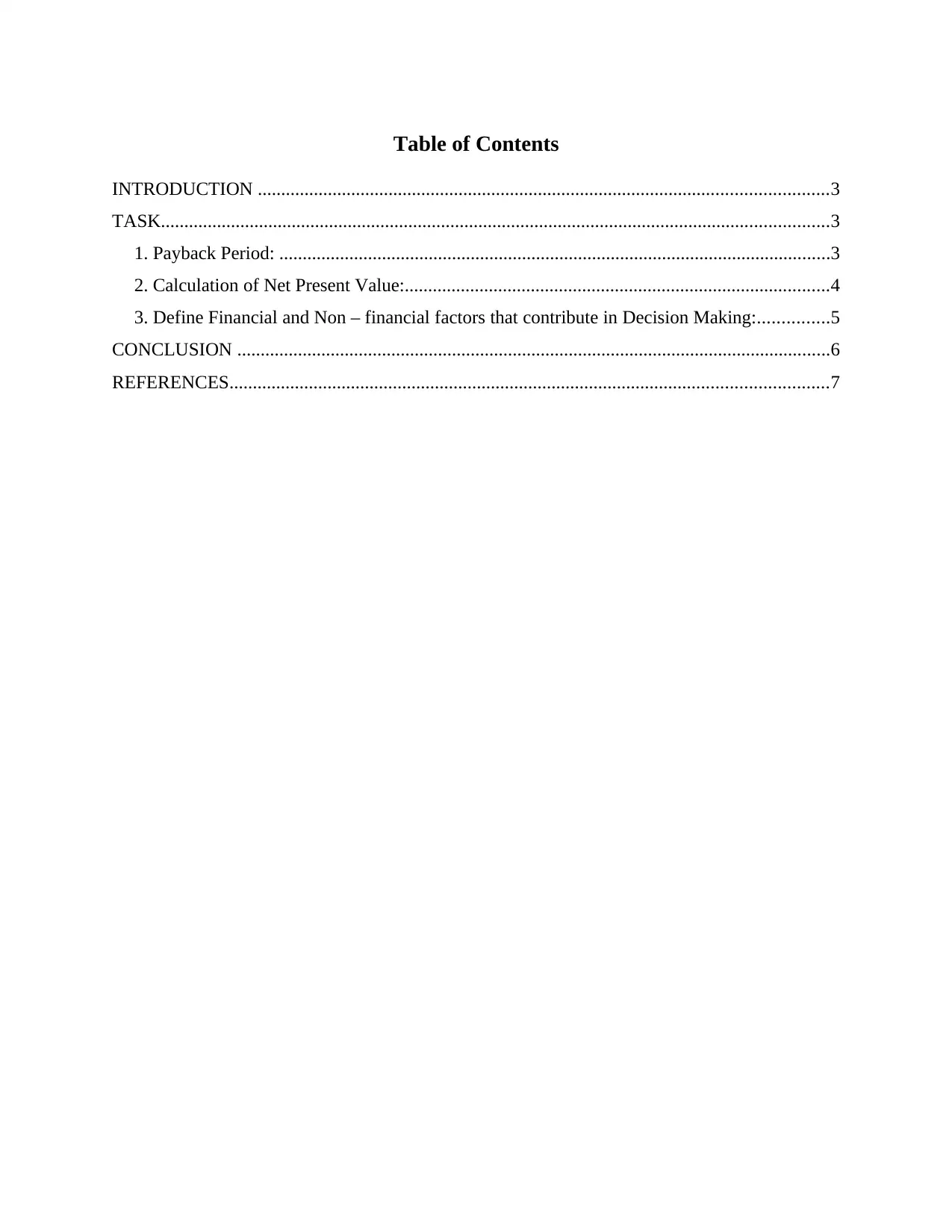
Table of Contents
INTRODUCTION ..........................................................................................................................3
TASK...............................................................................................................................................3
1. Payback Period: ......................................................................................................................3
2. Calculation of Net Present Value:...........................................................................................4
3. Define Financial and Non – financial factors that contribute in Decision Making:...............5
CONCLUSION ...............................................................................................................................6
REFERENCES................................................................................................................................7
INTRODUCTION ..........................................................................................................................3
TASK...............................................................................................................................................3
1. Payback Period: ......................................................................................................................3
2. Calculation of Net Present Value:...........................................................................................4
3. Define Financial and Non – financial factors that contribute in Decision Making:...............5
CONCLUSION ...............................................................................................................................6
REFERENCES................................................................................................................................7
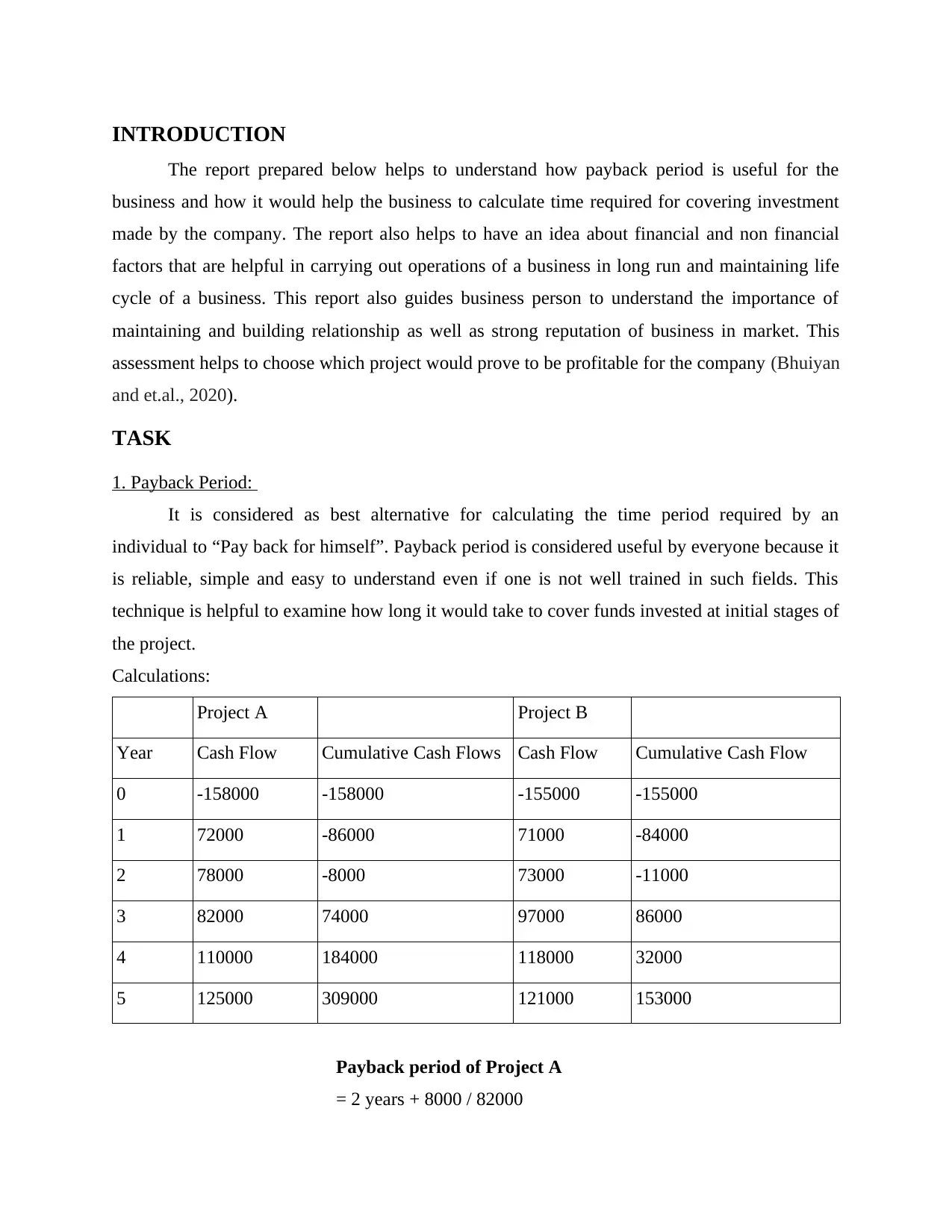
INTRODUCTION
The report prepared below helps to understand how payback period is useful for the
business and how it would help the business to calculate time required for covering investment
made by the company. The report also helps to have an idea about financial and non financial
factors that are helpful in carrying out operations of a business in long run and maintaining life
cycle of a business. This report also guides business person to understand the importance of
maintaining and building relationship as well as strong reputation of business in market. This
assessment helps to choose which project would prove to be profitable for the company (Bhuiyan
and et.al., 2020).
TASK
1. Payback Period:
It is considered as best alternative for calculating the time period required by an
individual to “Pay back for himself”. Payback period is considered useful by everyone because it
is reliable, simple and easy to understand even if one is not well trained in such fields. This
technique is helpful to examine how long it would take to cover funds invested at initial stages of
the project.
Calculations:
Project A Project B
Year Cash Flow Cumulative Cash Flows Cash Flow Cumulative Cash Flow
0 -158000 -158000 -155000 -155000
1 72000 -86000 71000 -84000
2 78000 -8000 73000 -11000
3 82000 74000 97000 86000
4 110000 184000 118000 32000
5 125000 309000 121000 153000
Payback period of Project A
= 2 years + 8000 / 82000
The report prepared below helps to understand how payback period is useful for the
business and how it would help the business to calculate time required for covering investment
made by the company. The report also helps to have an idea about financial and non financial
factors that are helpful in carrying out operations of a business in long run and maintaining life
cycle of a business. This report also guides business person to understand the importance of
maintaining and building relationship as well as strong reputation of business in market. This
assessment helps to choose which project would prove to be profitable for the company (Bhuiyan
and et.al., 2020).
TASK
1. Payback Period:
It is considered as best alternative for calculating the time period required by an
individual to “Pay back for himself”. Payback period is considered useful by everyone because it
is reliable, simple and easy to understand even if one is not well trained in such fields. This
technique is helpful to examine how long it would take to cover funds invested at initial stages of
the project.
Calculations:
Project A Project B
Year Cash Flow Cumulative Cash Flows Cash Flow Cumulative Cash Flow
0 -158000 -158000 -155000 -155000
1 72000 -86000 71000 -84000
2 78000 -8000 73000 -11000
3 82000 74000 97000 86000
4 110000 184000 118000 32000
5 125000 309000 121000 153000
Payback period of Project A
= 2 years + 8000 / 82000
⊘ This is a preview!⊘
Do you want full access?
Subscribe today to unlock all pages.

Trusted by 1+ million students worldwide
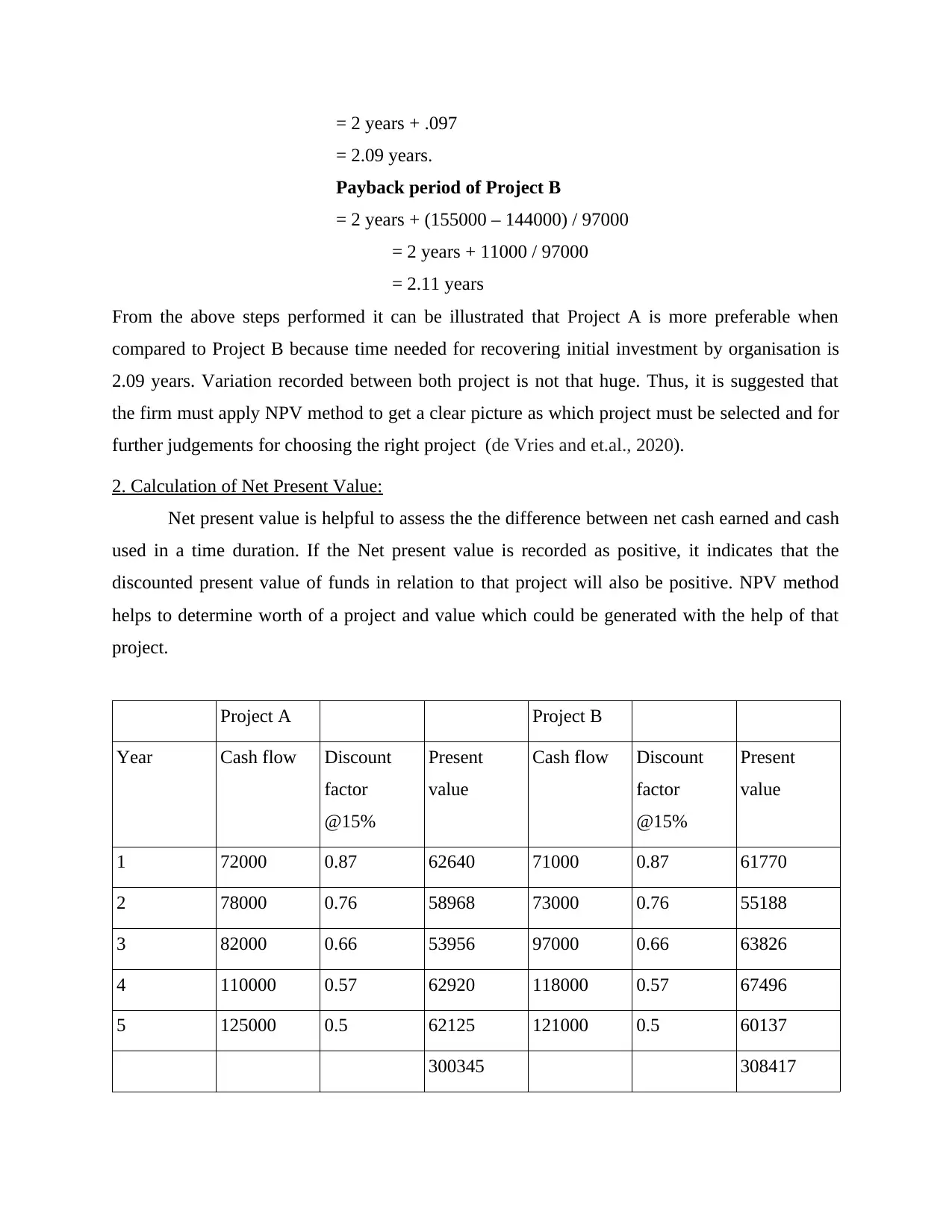
= 2 years + .097
= 2.09 years.
Payback period of Project B
= 2 years + (155000 – 144000) / 97000
= 2 years + 11000 / 97000
= 2.11 years
From the above steps performed it can be illustrated that Project A is more preferable when
compared to Project B because time needed for recovering initial investment by organisation is
2.09 years. Variation recorded between both project is not that huge. Thus, it is suggested that
the firm must apply NPV method to get a clear picture as which project must be selected and for
further judgements for choosing the right project (de Vries and et.al., 2020).
2. Calculation of Net Present Value:
Net present value is helpful to assess the the difference between net cash earned and cash
used in a time duration. If the Net present value is recorded as positive, it indicates that the
discounted present value of funds in relation to that project will also be positive. NPV method
helps to determine worth of a project and value which could be generated with the help of that
project.
Project A Project B
Year Cash flow Discount
factor
@15%
Present
value
Cash flow Discount
factor
@15%
Present
value
1 72000 0.87 62640 71000 0.87 61770
2 78000 0.76 58968 73000 0.76 55188
3 82000 0.66 53956 97000 0.66 63826
4 110000 0.57 62920 118000 0.57 67496
5 125000 0.5 62125 121000 0.5 60137
300345 308417
= 2.09 years.
Payback period of Project B
= 2 years + (155000 – 144000) / 97000
= 2 years + 11000 / 97000
= 2.11 years
From the above steps performed it can be illustrated that Project A is more preferable when
compared to Project B because time needed for recovering initial investment by organisation is
2.09 years. Variation recorded between both project is not that huge. Thus, it is suggested that
the firm must apply NPV method to get a clear picture as which project must be selected and for
further judgements for choosing the right project (de Vries and et.al., 2020).
2. Calculation of Net Present Value:
Net present value is helpful to assess the the difference between net cash earned and cash
used in a time duration. If the Net present value is recorded as positive, it indicates that the
discounted present value of funds in relation to that project will also be positive. NPV method
helps to determine worth of a project and value which could be generated with the help of that
project.
Project A Project B
Year Cash flow Discount
factor
@15%
Present
value
Cash flow Discount
factor
@15%
Present
value
1 72000 0.87 62640 71000 0.87 61770
2 78000 0.76 58968 73000 0.76 55188
3 82000 0.66 53956 97000 0.66 63826
4 110000 0.57 62920 118000 0.57 67496
5 125000 0.5 62125 121000 0.5 60137
300345 308417
Paraphrase This Document
Need a fresh take? Get an instant paraphrase of this document with our AI Paraphraser
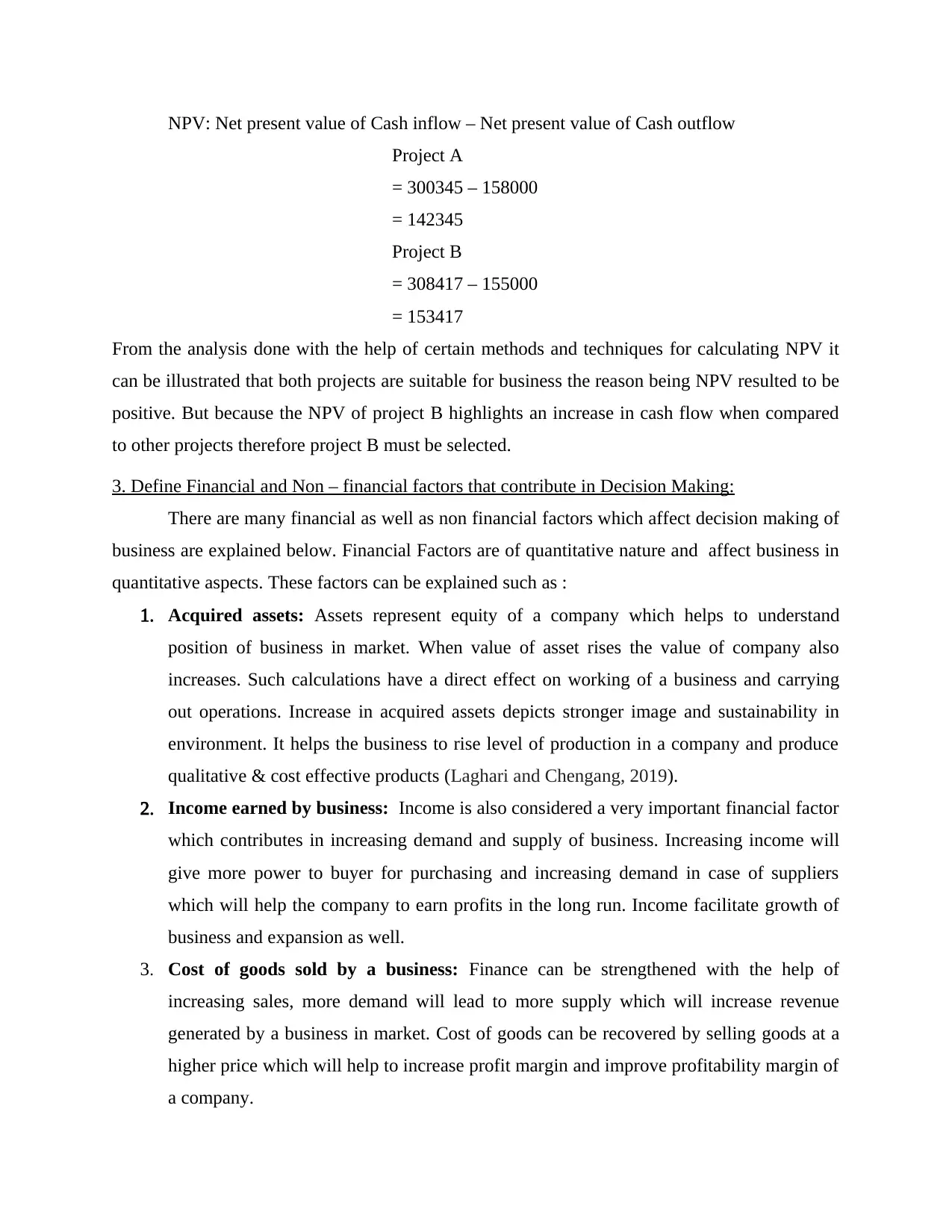
NPV: Net present value of Cash inflow – Net present value of Cash outflow
Project A
= 300345 – 158000
= 142345
Project B
= 308417 – 155000
= 153417
From the analysis done with the help of certain methods and techniques for calculating NPV it
can be illustrated that both projects are suitable for business the reason being NPV resulted to be
positive. But because the NPV of project B highlights an increase in cash flow when compared
to other projects therefore project B must be selected.
3. Define Financial and Non – financial factors that contribute in Decision Making:
There are many financial as well as non financial factors which affect decision making of
business are explained below. Financial Factors are of quantitative nature and affect business in
quantitative aspects. These factors can be explained such as :
1. Acquired assets: Assets represent equity of a company which helps to understand
position of business in market. When value of asset rises the value of company also
increases. Such calculations have a direct effect on working of a business and carrying
out operations. Increase in acquired assets depicts stronger image and sustainability in
environment. It helps the business to rise level of production in a company and produce
qualitative & cost effective products (Laghari and Chengang, 2019).
2. Income earned by business: Income is also considered a very important financial factor
which contributes in increasing demand and supply of business. Increasing income will
give more power to buyer for purchasing and increasing demand in case of suppliers
which will help the company to earn profits in the long run. Income facilitate growth of
business and expansion as well.
3. Cost of goods sold by a business: Finance can be strengthened with the help of
increasing sales, more demand will lead to more supply which will increase revenue
generated by a business in market. Cost of goods can be recovered by selling goods at a
higher price which will help to increase profit margin and improve profitability margin of
a company.
Project A
= 300345 – 158000
= 142345
Project B
= 308417 – 155000
= 153417
From the analysis done with the help of certain methods and techniques for calculating NPV it
can be illustrated that both projects are suitable for business the reason being NPV resulted to be
positive. But because the NPV of project B highlights an increase in cash flow when compared
to other projects therefore project B must be selected.
3. Define Financial and Non – financial factors that contribute in Decision Making:
There are many financial as well as non financial factors which affect decision making of
business are explained below. Financial Factors are of quantitative nature and affect business in
quantitative aspects. These factors can be explained such as :
1. Acquired assets: Assets represent equity of a company which helps to understand
position of business in market. When value of asset rises the value of company also
increases. Such calculations have a direct effect on working of a business and carrying
out operations. Increase in acquired assets depicts stronger image and sustainability in
environment. It helps the business to rise level of production in a company and produce
qualitative & cost effective products (Laghari and Chengang, 2019).
2. Income earned by business: Income is also considered a very important financial factor
which contributes in increasing demand and supply of business. Increasing income will
give more power to buyer for purchasing and increasing demand in case of suppliers
which will help the company to earn profits in the long run. Income facilitate growth of
business and expansion as well.
3. Cost of goods sold by a business: Finance can be strengthened with the help of
increasing sales, more demand will lead to more supply which will increase revenue
generated by a business in market. Cost of goods can be recovered by selling goods at a
higher price which will help to increase profit margin and improve profitability margin of
a company.
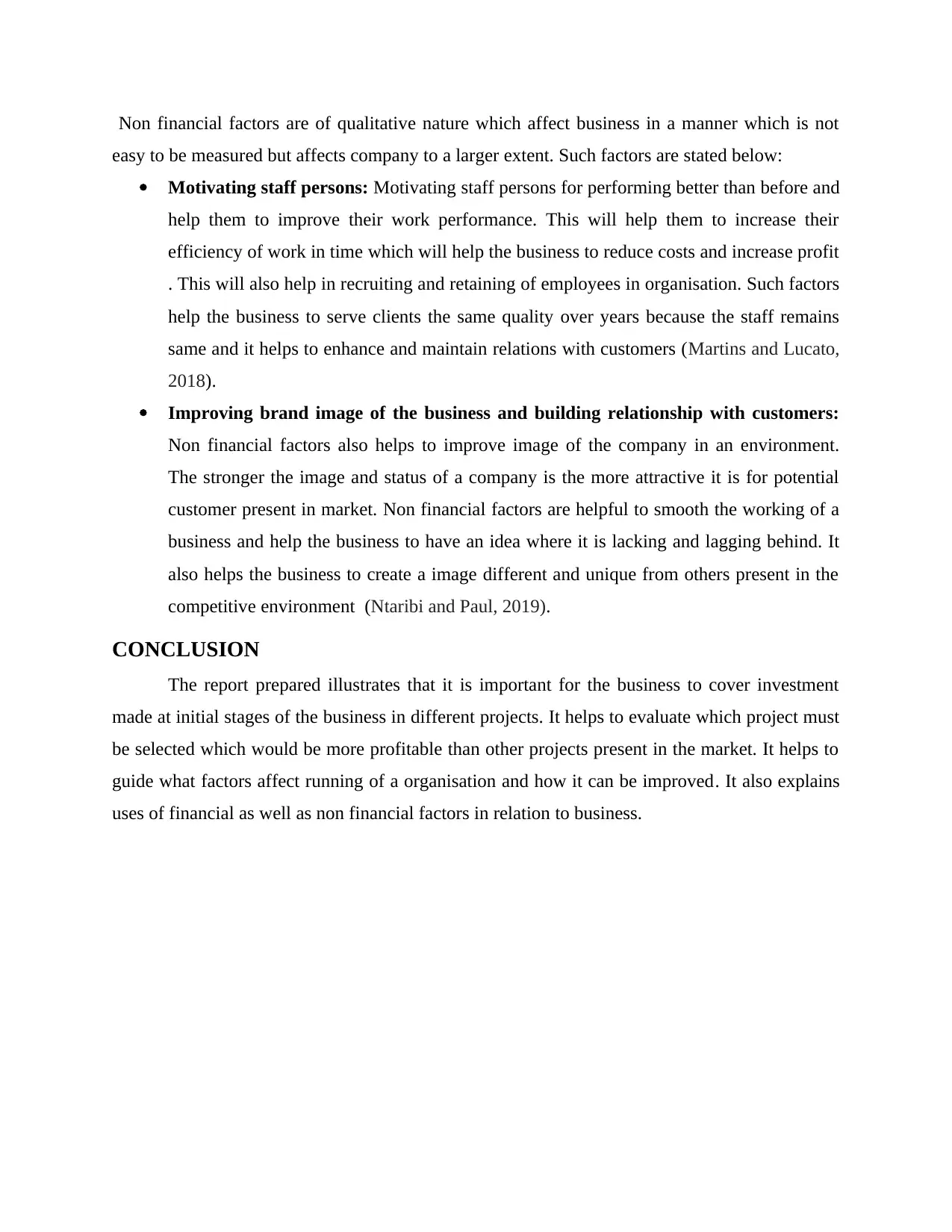
Non financial factors are of qualitative nature which affect business in a manner which is not
easy to be measured but affects company to a larger extent. Such factors are stated below:
Motivating staff persons: Motivating staff persons for performing better than before and
help them to improve their work performance. This will help them to increase their
efficiency of work in time which will help the business to reduce costs and increase profit
. This will also help in recruiting and retaining of employees in organisation. Such factors
help the business to serve clients the same quality over years because the staff remains
same and it helps to enhance and maintain relations with customers (Martins and Lucato,
2018).
Improving brand image of the business and building relationship with customers:
Non financial factors also helps to improve image of the company in an environment.
The stronger the image and status of a company is the more attractive it is for potential
customer present in market. Non financial factors are helpful to smooth the working of a
business and help the business to have an idea where it is lacking and lagging behind. It
also helps the business to create a image different and unique from others present in the
competitive environment (Ntaribi and Paul, 2019).
CONCLUSION
The report prepared illustrates that it is important for the business to cover investment
made at initial stages of the business in different projects. It helps to evaluate which project must
be selected which would be more profitable than other projects present in the market. It helps to
guide what factors affect running of a organisation and how it can be improved. It also explains
uses of financial as well as non financial factors in relation to business.
easy to be measured but affects company to a larger extent. Such factors are stated below:
Motivating staff persons: Motivating staff persons for performing better than before and
help them to improve their work performance. This will help them to increase their
efficiency of work in time which will help the business to reduce costs and increase profit
. This will also help in recruiting and retaining of employees in organisation. Such factors
help the business to serve clients the same quality over years because the staff remains
same and it helps to enhance and maintain relations with customers (Martins and Lucato,
2018).
Improving brand image of the business and building relationship with customers:
Non financial factors also helps to improve image of the company in an environment.
The stronger the image and status of a company is the more attractive it is for potential
customer present in market. Non financial factors are helpful to smooth the working of a
business and help the business to have an idea where it is lacking and lagging behind. It
also helps the business to create a image different and unique from others present in the
competitive environment (Ntaribi and Paul, 2019).
CONCLUSION
The report prepared illustrates that it is important for the business to cover investment
made at initial stages of the business in different projects. It helps to evaluate which project must
be selected which would be more profitable than other projects present in the market. It helps to
guide what factors affect running of a organisation and how it can be improved. It also explains
uses of financial as well as non financial factors in relation to business.
⊘ This is a preview!⊘
Do you want full access?
Subscribe today to unlock all pages.

Trusted by 1+ million students worldwide
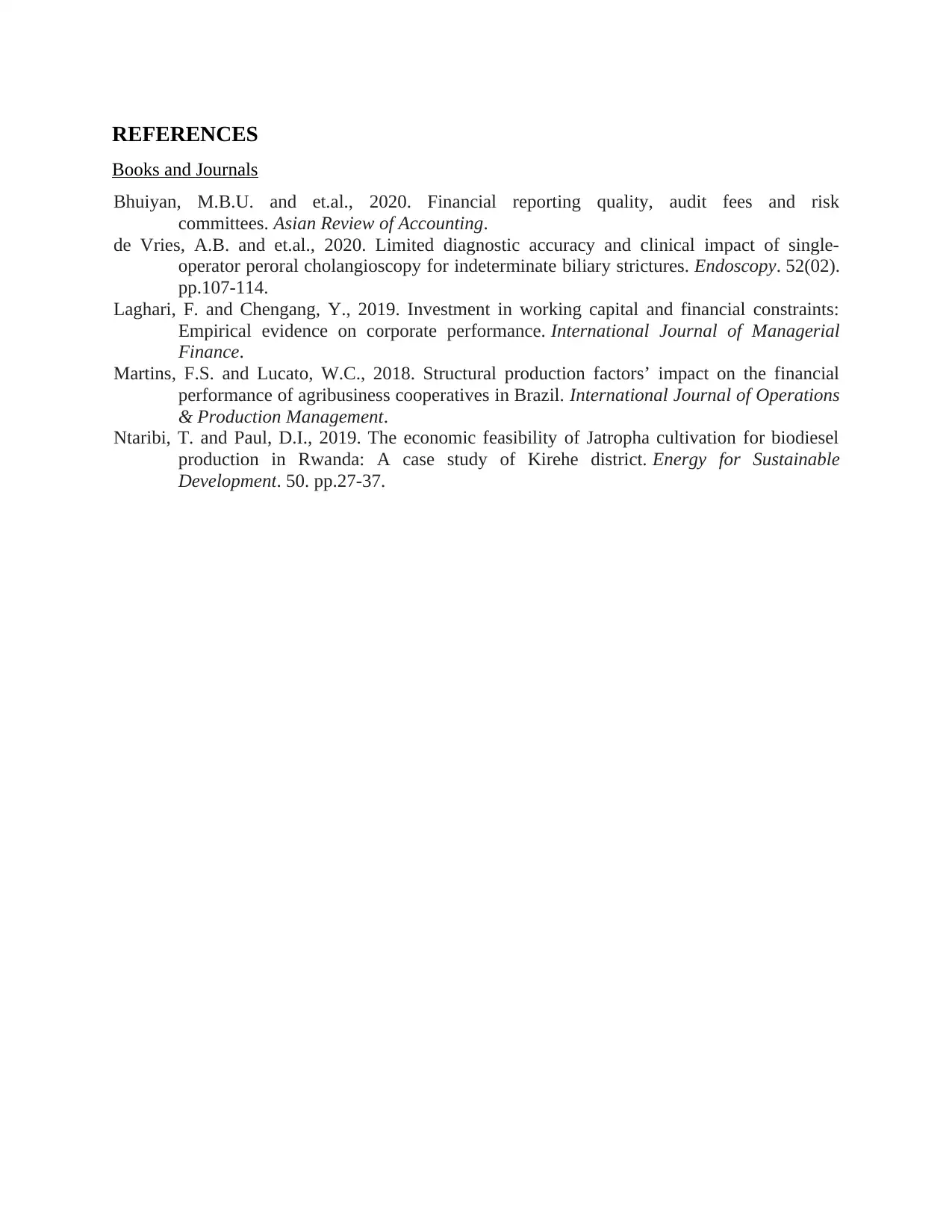
REFERENCES
Books and Journals
Bhuiyan, M.B.U. and et.al., 2020. Financial reporting quality, audit fees and risk
committees. Asian Review of Accounting.
de Vries, A.B. and et.al., 2020. Limited diagnostic accuracy and clinical impact of single-
operator peroral cholangioscopy for indeterminate biliary strictures. Endoscopy. 52(02).
pp.107-114.
Laghari, F. and Chengang, Y., 2019. Investment in working capital and financial constraints:
Empirical evidence on corporate performance. International Journal of Managerial
Finance.
Martins, F.S. and Lucato, W.C., 2018. Structural production factors’ impact on the financial
performance of agribusiness cooperatives in Brazil. International Journal of Operations
& Production Management.
Ntaribi, T. and Paul, D.I., 2019. The economic feasibility of Jatropha cultivation for biodiesel
production in Rwanda: A case study of Kirehe district. Energy for Sustainable
Development. 50. pp.27-37.
Books and Journals
Bhuiyan, M.B.U. and et.al., 2020. Financial reporting quality, audit fees and risk
committees. Asian Review of Accounting.
de Vries, A.B. and et.al., 2020. Limited diagnostic accuracy and clinical impact of single-
operator peroral cholangioscopy for indeterminate biliary strictures. Endoscopy. 52(02).
pp.107-114.
Laghari, F. and Chengang, Y., 2019. Investment in working capital and financial constraints:
Empirical evidence on corporate performance. International Journal of Managerial
Finance.
Martins, F.S. and Lucato, W.C., 2018. Structural production factors’ impact on the financial
performance of agribusiness cooperatives in Brazil. International Journal of Operations
& Production Management.
Ntaribi, T. and Paul, D.I., 2019. The economic feasibility of Jatropha cultivation for biodiesel
production in Rwanda: A case study of Kirehe district. Energy for Sustainable
Development. 50. pp.27-37.
Paraphrase This Document
Need a fresh take? Get an instant paraphrase of this document with our AI Paraphraser


⊘ This is a preview!⊘
Do you want full access?
Subscribe today to unlock all pages.

Trusted by 1+ million students worldwide
1 out of 9
Related Documents
Your All-in-One AI-Powered Toolkit for Academic Success.
+13062052269
info@desklib.com
Available 24*7 on WhatsApp / Email
![[object Object]](/_next/static/media/star-bottom.7253800d.svg)
Unlock your academic potential
Copyright © 2020–2025 A2Z Services. All Rights Reserved. Developed and managed by ZUCOL.



